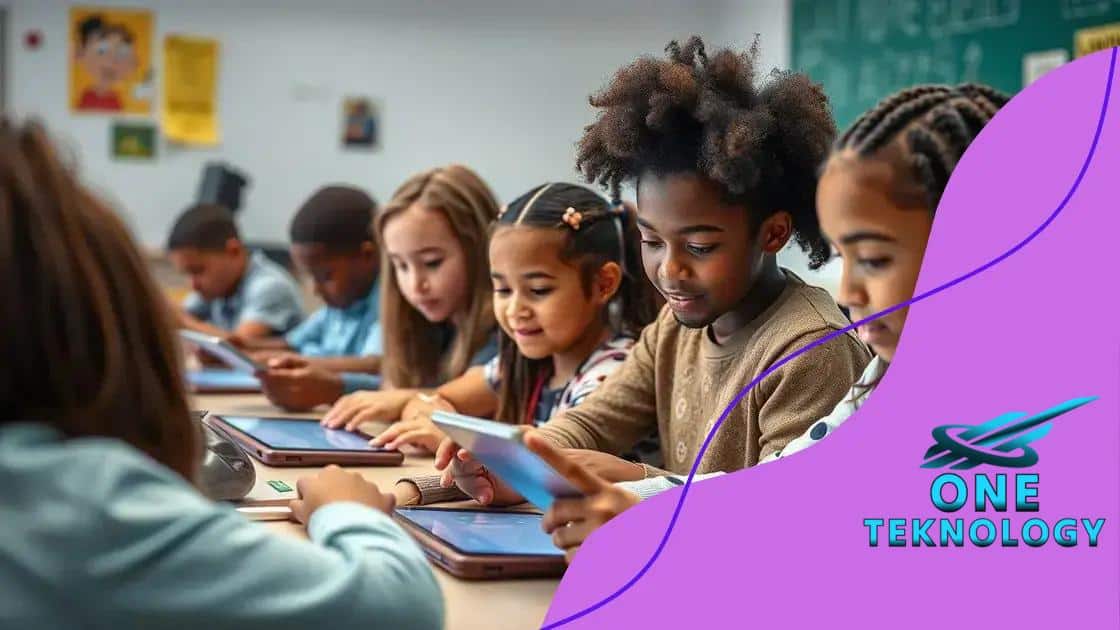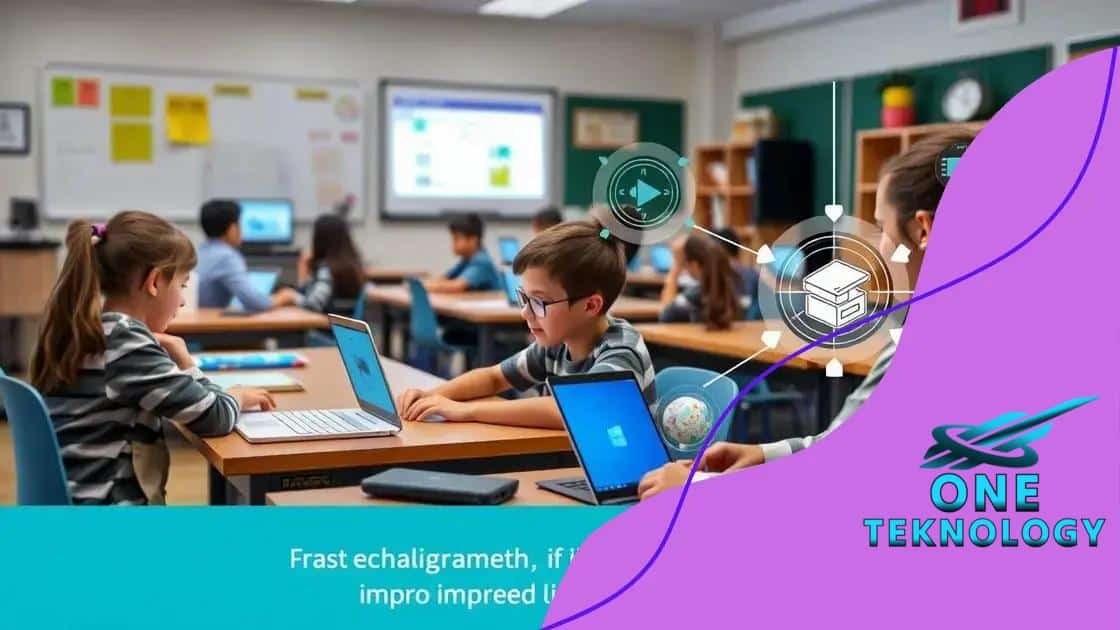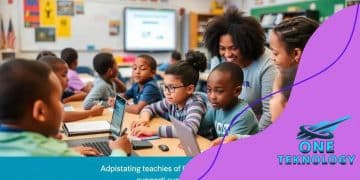How AI-driven learning platforms are transforming education

AI-driven learning platforms significantly enhance education outcomes by personalizing learning experiences, improving student engagement, and providing real-time feedback while addressing challenges such as data privacy and equitable access.
How AI-driven learning platforms are improving education outcomes starts with innovative technologies reshaping learning environments. Ever wondered how these tools make learning more engaging and effective? Let’s dive in!
Understanding AI-driven learning platforms
Understanding AI-driven learning platforms is crucial in today’s educational landscape. These platforms utilize artificial intelligence to create personalized learning experiences that cater to individual student needs. By analyzing data and adapting to various learning styles, they aim to improve educational outcomes.
Key Features of AI-driven Learning Platforms
These platforms often come with a variety of features designed to enhance the learning experience. Some of the key features include:
- Personalized Learning Paths: Tailors courses and materials to match each student’s learning speed and style.
- Real-time Feedback: Provides immediate assessments and suggestions to help students improve.
- Data Analytics: Analyzes performance metrics to identify strengths and weaknesses.
- Engagement Tools: Utilizes gamification and interactive content to maintain student interest.
Moreover, integrating these features creates an engaging environment where students can thrive. For instance, the use of personalized learning paths not only helps students progress at their own pace but also keeps them motivated. With real-time feedback, a student can understand their mistakes instantly, which accelerates the learning process.
The Role of Data in AI Learning
Data is the backbone of AI-driven learning platforms. It collects and analyzes interactions between the student and the material. This data helps in refining the learning experience and predicting future outcomes. For example, if a student struggles with a specific topic, the system can adjust the materials presented to focus more on that area.
Furthermore, educational institutions benefit significantly from this data. They can track overall student performance and identify trends that could inform teaching strategies. With the right insights, teachers can adjust their approaches to better serve their students.
Challenges of Implementing AI in Education
Despite the benefits, there are challenges to implementing AI-driven learning platforms. Issues related to data privacy, technology access, and the need for training educators are common hurdles. Schools must ensure they have the proper infrastructure and resources before adopting these technologies.
As technology continues to evolve, it is essential for educators to stay informed about these advancements. The future of learning might rely heavily on AI, making comprehension of these platforms fundamental to the success of both students and educational institutions.
Benefits of personalized learning experiences
The benefits of personalized learning experiences are profound and transformative. By tailoring education to meet individual needs, students can engage in a way that suits their unique learning styles. This approach revolutionizes the traditional classroom setting.
Enhanced Student Engagement
One major benefit is increased engagement. When students encounter materials that resonate with them, they are more likely to participate actively. Personalized learning encourages students to take charge of their education, leading to deeper involvement.
- Motivation: Students feel more motivated when lessons relate to their interests.
- Ownership: Personalization allows students to take ownership of their learning paths.
- Focus: Customized lessons help maintain focus by aligning with students’ strengths and weaknesses.
Furthermore, personalized learning fosters a sense of responsibility. Students often become more accountable for their progress as they navigate through tailored content. This autonomy not only boosts self-esteem but also prepares them for future challenges.
Improved Academic Performance
Another essential benefit is improved academic performance. As students learn at their own pace, they can grasp concepts more thoroughly. This tailored approach often leads to higher test scores and better retention of knowledge.
Educational technology plays a significant role in enhancing these experiences. By utilizing assessments and analytics, AI-driven learning platforms adjust to each student’s progress. If a student struggles with a concept, the platform can provide additional resources or alternative methods to help strengthen understanding.
With the right support, personalized learning not only improves grades but also cultivates a love for learning. Each achievement reinforces the notion that students can succeed on their terms, fostering long-term educational success.
Inclusivity and Accessibility
Personalized learning experiences also promote inclusivity. By accommodating diverse learning needs, all students benefit, including those with disabilities. This adaptability means that educators can use various methods to reach every learner.
Moreover, technology has made personalized learning more accessible than ever. Students from different backgrounds can access high-quality learning materials from anywhere. This democratization of education ensures that no learner is left behind, regardless of their circumstances.
Real-world examples of improved educational outcomes

Real-world examples of improved educational outcomes illustrate the effectiveness of AI-driven learning platforms in diverse educational settings. These platforms have been at the forefront of transforming education, producing remarkable results.
Case Study: Khan Academy
Khan Academy is a prime example of how personalized learning can make a difference. Through its platform, students receive tailored exercises that adapt to their learning pace. By focusing on mastery, learners can revisit challenging topics until they fully understand them.
- Results: Many students demonstrate significant improvements in math scores after using Khan Academy for consistent practice.
- Engagement: The platform’s gamified elements keep learners motivated and engaged in their studies.
- Accessibility: It provides free resources to millions of students worldwide, ensuring everyone has a chance to learn.
Additionally, schools that have incorporated Khan Academy into their curriculum reported higher student participation rates and enthusiasm towards learning. This platform exemplifies how technology can enhance students’ academic performance.
Case Study: DreamBox Learning
Another notable example is DreamBox Learning, a math program that utilizes adaptive learning technology. It personalizes lessons based on real-time data and student interactions. As students engage with the program, DreamBox assesses their strengths and challenges, adjusting the curriculum as needed.
The outcomes are impressive. Schools that have integrated DreamBox notice significant growth in math proficiency. Teachers appreciate the insightful data analytics, allowing them to tailor their instruction effectively.
Students using DreamBox have reported feeling more confident in their math abilities. This confidence leads to increased participation in class discussions and a stronger passion for learning.
Case Study: AltSchool
AltSchool uses a unique model focused on personalized education. They combine technology with a curriculum that adjusts to each student’s interests and abilities. This environment fosters creativity and self-directed learning.
Results from AltSchool display impressive gains in both academic and social-emotional skills. Students develop stronger critical thinking abilities and collaboration skills, crucial for success in the modern world.
These real-world examples showcase how AI-driven learning platforms are not just theoretical; they have practical applications that significantly enhance educational outcomes. By leveraging technology, schools can provide better, more personalized education, ultimately benefiting students and their future prospects.
Challenges to implementing AI in education
Implementing AI in education comes with several challenges that schools and educators must navigate. While these technologies offer great potential, the path to integration is not always smooth.
Data Privacy Concerns
One significant challenge is data privacy. Students’ personal information is often collected by AI systems to personalize learning experiences. Schools must ensure that this data is protected and used ethically.
- Compliance: Educational institutions need to comply with regulations like FERPA and GDPR.
- Trust: Parents and students may be hesitant to use AI tools if they are unsure about data handling practices.
- Security: Protecting sensitive data from breaches is critical for any educational institution.
To mitigate these concerns, schools must adopt transparent data policies and educate stakeholders on security measures.
Technology Access and Equity
Another challenge is ensuring equity in technology access. Not all students have the same access to devices or reliable internet connections. This disparity can lead to a digital divide that hinders some students’ learning experiences.
Bridging this gap is essential for successful AI implementation. Schools must explore options to provide necessary resources to underprivileged students. Initiatives such as device lending programs or community internet access can help address this issue.
Teacher Training and Support
Teachers also face challenges when it comes to using AI tools effectively. They need proper training to understand how to implement these technologies in their classrooms. Without adequate support, educators may resist adopting AI platforms.
Professional development programs are essential for equipping teachers with the skills they need. These programs should focus on how to integrate AI-driven learning platforms into everyday lesson plans, helping to foster a new wave of education.
Resistance to Change
Finally, there can be a natural resistance to change within educational institutions. Stakeholders may be hesitant to shift away from traditional teaching methods. Building consensus and support for AI initiatives is vital.
Open discussions involving teachers, parents, and administrators can help ease these concerns. By highlighting the potential benefits and sharing success stories, schools can foster a culture of innovation.
Future trends in educational technology
The future of educational technology is bright and full of innovative possibilities. As we continue to see advancements in AI and other technologies, the educational landscape is poised for a significant transformation.
Integration of Artificial Intelligence
Artificial intelligence will play a crucial role in shaping the future of education. AI-driven learning platforms will become more sophisticated, offering tailored experiences for each student. This means that students will benefit from customized lessons, real-time feedback, and targeted resources that cater specifically to their unique learning needs.
- Adaptive Learning: AI will enable systems to adjust material based on student performance, ensuring optimal learning conditions.
- Automated Assessments: Testing and grading may move toward automation, allowing teachers to focus more on instruction and less on paperwork.
- Enhanced Analytics: Schools will utilize data analytics to gain insights into student performance, making informed decisions that promote success.
As AI continues to evolve, educators will face new opportunities and challenges in integrating these tools effectively.
Personalized Learning Experiences
Another significant trend is the rise of personalized learning experiences. Tailored education allows students to advance at their own pace, exploring subjects that interest them most. This approach not only enhances engagement but also improves retention rates.
Technology will enable personalized learning through:
- Learning Management Systems: These platforms will provide resources and support that adapt to the individual learning styles of students.
- Gamification: Incorporating game elements will motivate students and keep them engaged in their learning journey.
- Virtual Reality: VR technology will create immersive learning environments that enhance understanding and retention.
By focusing on personalized learning, educators can nurture a generation of independent and motivated learners.
Blended Learning Environments
Future educational settings will likely leverage blended learning models. This hybrid approach combines traditional face-to-face instruction with online learning opportunities. As technology becomes more accessible, classrooms will become dynamic spaces where students can thrive.
Benefits of blended learning include:
- Flexible Scheduling: Students can learn at their convenience, balancing both in-person and online activities.
- Improved Collaboration: Online platforms will enable students to collaborate on projects and assignments regardless of location.
- Increased Resource Variety: Teachers will have access to a wealth of digital resources that can enrich the learning experience.
With these trends in mind, the educational landscape is about to undergo significant changes, paving the way for more effective and engaging learning experiences for students worldwide.
FAQ – Frequently Asked Questions about AI-Driven Learning Platforms
How does AI improve personalized learning experiences?
AI analyzes student data to tailor lessons, ensuring each learner receives content that suits their personal needs and skills.
What are some challenges in implementing AI in education?
Challenges include data privacy concerns, ensuring equitable access to technology, and providing adequate teacher training.
Can AI-driven platforms enhance student engagement?
Yes, these platforms create more interactive and personalized experiences, leading to increased motivation and participation among students.
What does the future hold for educational technology?
The future includes more advanced AI integration, personalized learning paths, and blended learning environments that combine traditional and online methods.






